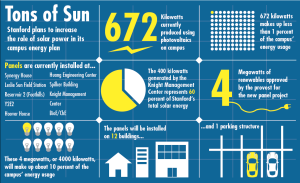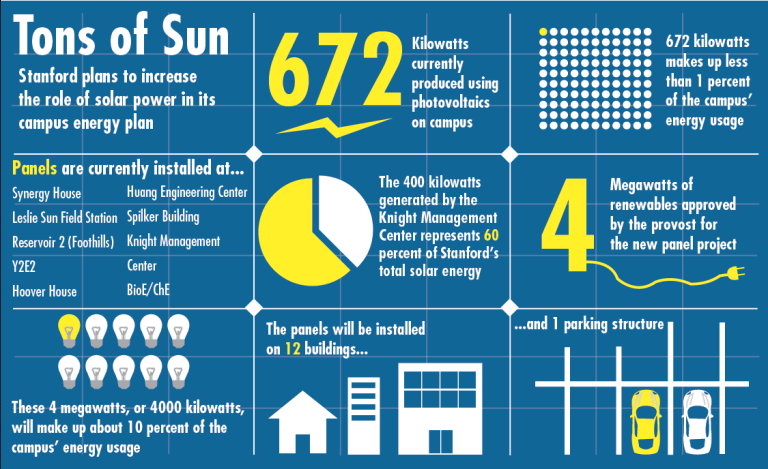
Provost John Etchemendy Ph.D. ‘82 recently approved an Office of Sustainability initiative to install solar panels on a parking structure and on twelve other buildings across campus as a companion project to the Stanford Energy Systems Innovations (SESI) initiative.
The panels will increase the total wattage provided by photovoltaic cells on campus by nearly a factor of six, from 672 kilowatts to a projected four megawatts. The new panels will also up the percentage of energy derived from photovoltaic cells relative to the campus’s overall energy consumption, from under one percent to about 10 percent.
According to Fahmida Ahmed, associate director of the Office of Sustainability, the panels will accompany the Stanford Energy System Innovations (SESI) initiative, which was approved by the Board of Trustees in 2011. SESI aims to move Stanford away from a cogeneration energy system reliant on natural gas towards a heat recovery system that will–according to Stanford Facts–reduce campus greenhouse emissions by 50 percent.
The new energy system features an electricity-based power plant that will also open up options to transition from fossil fuel-based technology to open-source technology. The solar panels’ installation will supplement the system by expanding its range of clean energy sources.
According to Scott Gould, senior engineer for building energy systems commissioning, some developmental work on the panels’ installation took place in Stanford labs. The panel project has also incorporated assistance from student groups like the Stanford Solar and Wind Energy Project (SWEP) and Students for a Sustainable Stanford (SSS).
Ahmed explained that students have been involved with SESI since its inception, performing tasks like testing the efficiency of the initial photovoltaic modules, supporting research on renewables and spreading the word about sustainability initiatives to other students.
Josh Lappen ‘17, a member of the SSS energy and climate subgroup, said that he hopes this project will excite more students about sustainability efforts on campus.
“The issue with environmental conservation concerns, especially with energy production, is that it doesn’t seem like anything on a small scale or even on a university scale can make a difference in the larger worldwide impact,” Lappen said. “This is a project big enough that I think the impact is evident.”
While SESI is scheduled to finish construction in April 2015, the timeline for installing the panels remains subject to finding a financial partner for the project as well as the installation of basic infrastructure, like electrical conduits, in the targeted buildings.
For students like Lappen, the project is more than just an environmental initiative–it is the University’s attempt to lead by example.
“Stanford exhorts us to provide moral leadership,” Lappen said. “Energy production that isn’t clean or renewable doesn’t just impact the environment. It impacts people, like those who live near a coal power plant or people who live in low-lying areas where water is rising in other parts of the world.”
“I think [the project] is in line with our core values as a community at Stanford to take responsibility for what we’re getting here,” he continued. “People are excited to see that the university is very much in tune with developing thought on this…that it’s our job to help pay back.”
Contact Madeleine Han at mhan95 ‘at’ stanford ‘dot’ edu.
